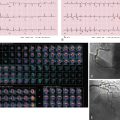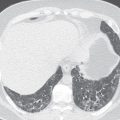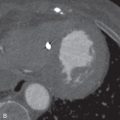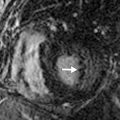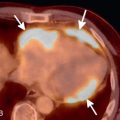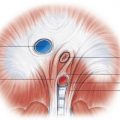■
Introduction
The mediastinum, chest wall, and diaphragm can be evaluated by multiple imaging modalities, such as radiography, computed tomography (CT), and magnetic resonance imaging (MRI). The chest radiograph is often the initial imaging modality used in the evaluation of these structures and their abnormalities. CT and MRI are important cross-sectional imaging modalities that are useful in the evaluation and characterization of abnormalities in these structures. A thorough understanding of the normal anatomy is essential for the accurate diagnosis of cardiopulmonary disease.
In this chapter, we review the imaging anatomy of the mediastinum, chest wall, and diaphragm.
■
Mediastinum
The mediastinum is the central compartment of the thorax that is bounded by pleura on the right and left, by sternum anteriorly, and by vertebra posteriorly. It contains loose connective tissue and several vital structures, including the heart, great vessels, esophagus, trachea, phrenic and cardiac nerves, thoracic duct, lymph nodes, and thymus. Craniocaudally, it extends from the thoracic inlet superiorly to the diaphragm inferiorly. The mediastinum is divided into compartments based on multiple classification schemes. However, there are no real anatomic boundaries for these compartments; hence, disease processes may extend from one compartment to another. Also, these classification schemes are less relevant with the use of CT and MRI, where the masses can be accurately localized and reasonably characterized.
In the traditional anatomic four-compartment classification, mediastinum is divided into superior and inferior compartments, with the inferior further subdivided into anterior, middle, and posterior compartments. The superior compartment extends from the thoracic inlet to the level of the superior aortic arch—that is, superior to an imaginary line between the manubriosternal angle and the T4–5 intervertebral disk in the lateral radiograph or sagittal tomogram. The inferior mediastinum extends from this level to the diaphragm. The anterior mediastinum is bounded anteriorly by the sternum and posteriorly by the anterior pericardium. This space contains the thymus, lymph nodes, internal mammary artery branches, and fat. The middle mediastinum is located between the anterior and posterior pericardium. The heart, aorta, pulmonary arteries, pulmonary veins, superior vena cava (SVC), inferior vena cava (IVC), phrenic nerve, trachea and proximal bronchi, esophagus, mediastinal fat, and lymph nodes are located in the middle mediastinum. The posterior mediastinum is located posterior to the posterior pericardium and contains vertebral bodies, nerves, fat, and lymph nodes.
There are several three-compartment classifications. The Felson classification is based on lateral radiographs. The anterior mediastinum is located between the sternum and an imaginary line drawn superiorly from the diaphragm along the back of the heart and front of the trachea. The middle mediastinum is located between the above-mentioned line and another imaginary line that is located 1 cm behind the anterior margins of the thoracic vertebra, and the posterior mediastinum is located posterior to this line ( Fig. 2.1A ). The Zylak classification is also similar, with the middle vascular space containing the pericardium and its contents, anterior aorta with its branches and great veins, an anterior prevascular space containing the thymus, thyroids, and parathyroids, and a posterior postvascular previsceral space containing the trachea, esophagus, descending aorta, and azygos. Shield’s three-zone classification has a previsceral zone between the sternum and anterior pericardium and great vessels; the visceral zone is between the anterior pericardium and the anterior surface of the spine, and the retrovisceral zone in the paravertebral sulci. In the Whitten classification, the anterior mediastinum is bounded anteriorly by the sternum and posteriorly by the anterior pericardium, aorta, and brachiocephalic vessels. The middle mediastinum is bounded anteriorly by the anterior pericardium and posteriorly by the posterior pericardium and trachea. The posterior mediastinum is bounded anteriorly by the posterior pericardium and posterior trachea and posteriorly by the vertebral column. In the Sone classification, the mediastinum is divided into anterior (precardiovascular) and central (retrocardiovascular) zones, with the latter divided into supracarinal and subcarinal areas. divided the mediastinum into the thoracic inlet, anterior mediastinum, supraaortic area (above the aortic arch), infraaortic area, supraazygos area (above the supraaortic aortic arch), and infraazygos area (below the supraaortic aortic arch). The Japanese Association for Research on Thymus (JART) system classifies the mediastinum into superior, anterior, middle, and posterior based on landmarks in axial cross-sectional images. The International Thymic Malignancy Interest Group (ITMIG) classification is a modification of the JART system; it divides the mediastinum into anterior (prevascular), middle (visceral), and posterior (paravertebral) based on CT landmarks. In this scheme, the boundary between the middle and posterior mediastinum is a vertical line 1 cm posterior to the anterior margin of the spine (see Fig. 2.1B ).
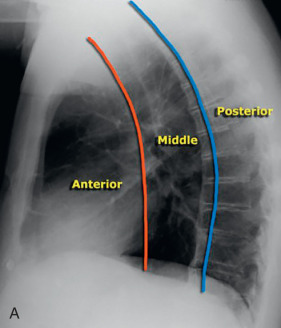
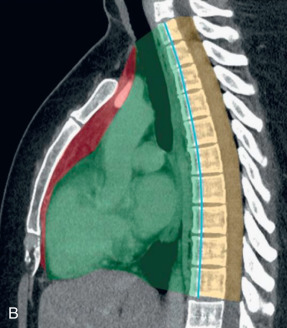
The thymus is located in the anterior mediastinum in the thyropericardiac space. There is a wide variation in morphology and size, particularly in children and young adults. The thymus is large at birth, often larger than the heart, and progressively decreases in size with age, with the gland being replaced by fatty infiltration. The thymus is atrophic in the fourth decade but may be seen in less than 50% of those older than 40 years on a CT scan. The normal maximal thickness in those younger than 20 years is 18 mm, and it is 13 mm in older individuals. The normal thymus is a homogeneous bilobulated structure, with the left lobe usually larger than the right. Rarely, there is congenital absence of a lobe. On CT, it has homogeneous soft tissue attenuation ( Fig. 2.2A ), and on MRI it has intermediate signal intensity (see Fig. 2.2B ). However, with age, the T1 signal of the thymus increases due to fat infiltration. On T2 images, the thymus has high signal intensity in all age groups. The normal thymus in patients younger than 20 years typically has diffuse increased fluorodeoxyglucose (FDG) uptake on positron emission tomography (PET). After that age, significant FDG accumulation is less common.
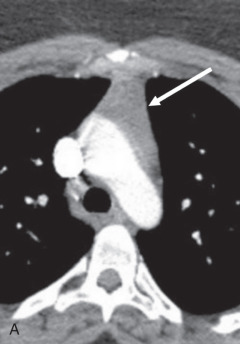
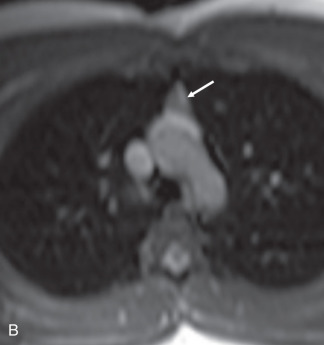
The trachea connects the larynx to the lungs. It extends from the inferior margin of the cricoid cartilage in the neck to the carina, which marks the origin of the main bronchi. It is located in the midline, but it may be located to the right at the level of the aortic arch. The trachea is 10 to 11 cm long in adults, with 6 to 9 cm of this being intrathoracic. However, tracheal length varies with respiration and neck flexion and extension. The normal tracheal lumen is round, oval, or horseshoe-shaped ( Fig. 2.3 ). In men, the tracheal diameter ranges from 13 to 25 mm in the coronal plane and 13 to 27 mm in the sagittal plane; in women, the tracheal diameter ranges from 10 to 21 mm in the coronal plane and 10 to 23 mm in the sagittal plane. The tracheal wall measures 1 to 3 mm on CT and is composed of inner mucosa, submucosa, cartilage and muscle, and outer adventitia. The posterior wall is thinner than the anterior and lateral walls. The trachea has 22 C -shaped cartilages, which are linked longitudinally by annular ligaments of fibrous and connective tissue. The cartilages are connected posteriorly by the membranous tracheal wall, which is supported by the trachealis muscle. With expiration, there is anterior bulging of the posterior membrane, resulting in a decreased anteroposterior dimension of 32%. The main bronchi originate from the trachea at the level of the carina and extend obliquely on the axial plane bilaterally. Normal variants of tracheobrochial tree are rare and are seen in less than 2.3% of cases. They include the tracheal bronchus (see Fig. 2.3D ), accessory cardiac bronchus, bronchus hypoplasia, and aplasia. They are relatively more common in males and most often are located on the right side.
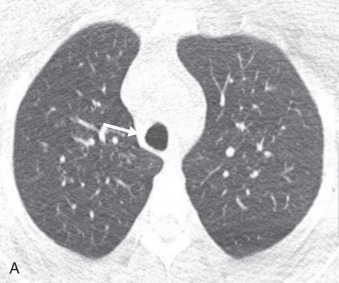

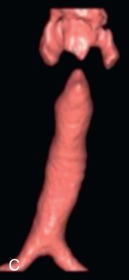
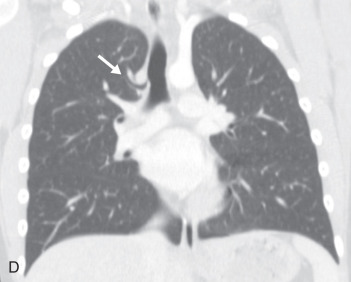
The esophagus is a muscular tube that connects the pharynx to the stomach. It is 23 to 37 cm long and has cervical, thoracic, and abdominal portions. The thoracic component extends from the level of T1 to the esophageal hiatus at T10. The esophagus is in close contact with several vital structures in the chest. Posteriorly, it is close to the descending aorta, thoracic duct, hemiazygos, and accessory hemiazygos ( Fig. 2.4 ). Anteriorly, it is close to the trachea, recurrent laryngeal nerve in the tracheoesophageal groove, left main bronchus, and left atrium. On the right, it is close to the pleura and azygos vein, whereas on the left it is close to the pleura, aorta, left subclavian artery, and thoracic duct. The superior portion of the esophagus is close to the trachea, whereas the lower portion is close to the descending thoracic aorta. The thoracic esophagus is initially located to the left of midline, returns to the midline at T5, and then courses to the left of midline again in the posterior mediastinum. In the inferior aspect of the thorax, it curves anteriorly to exit through the esophageal hiatus. There is a constriction in the thoracic esophagus at the level of the aortic arch at T4–5. When dilated, the esophagus thickness is between 1.9 and 2.7 mm.

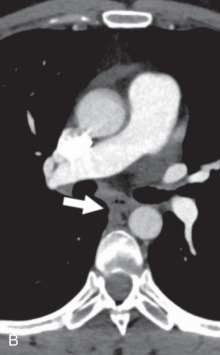
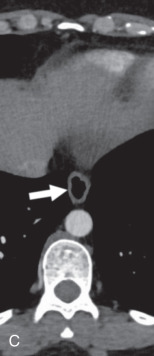
Lymph nodes are present at different locations in the mediastinum. As a rule of thumb, normal lymph nodes measure less than 10 mm and have a fatty hilum. It is important to describe the lymph node accurately, particularly in patients with lung cancer, because it is an important component of staging. The International Association for the Study of Lung Cancer (IASLC) has defined a lymph node map that helps in lung cancer staging ( Table 2.1 ; Fig. 2.5 ). There are 14 lymph node stations:
- •
1R: Right low cervical supraclavicular and sternal notch lymph nodes; located between the lower margins of the cricoid superiorly and the upper border of the manubrium and bilateral clavicles inferiorly, on the right.
- •
1L: Left low cervical supraclavicular and sternal notch lymph nodes, between the lower margin of the cricoid superiorly and upper border of the manubrium and bilateral clavicles inferiorly, on the left. The tracheal midline is the boundary between 1R and 1L.
- •
2R: Right upper paratracheal; its superior boundary is the upper border of the manubrium, apex of the right lung, and pleura, and the lower border is the intersection of the caudal innominate vein with the trachea ( Fig. 2.6A ).
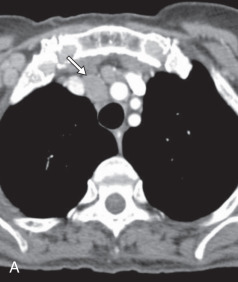
Figure 2.6
Examples of lymph nodes. Multiple axial CT scans at different levels showing the right upper paratracheal (A; arrow ), left upper paratracheal (B; arrow ), prevascular (C; arrow ), right lower paratracheal (D; arrow ), left lower paratracheal (E; arrow ), aortopulmonary window (F; arrow ), paraaortic (G; arrow ), subcarinal (H; arrow ) , paraesophageal (I), and right hilar (J; arrow ) lymph nodes.
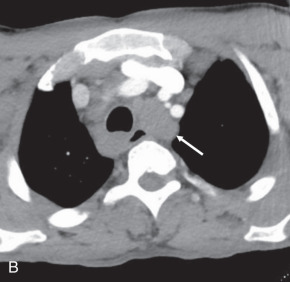
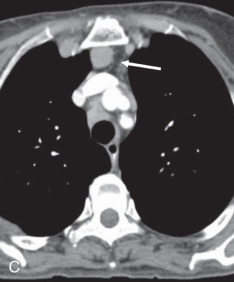
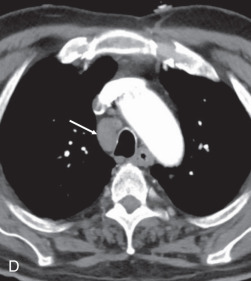


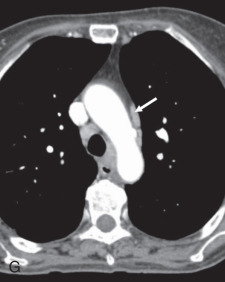
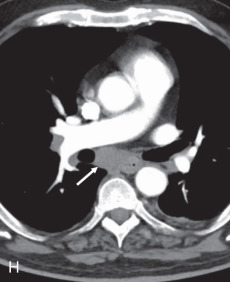
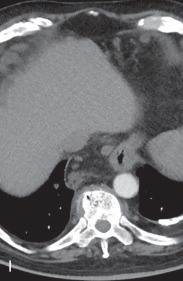
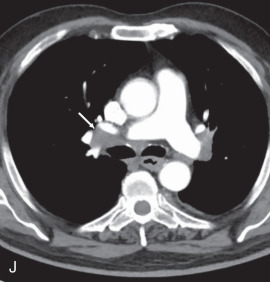
- •
2L: Left upper paratracheal, whose superior border is the upper border of manubrium, apex of the left lung, and pleura, and the lower border is the superior border of the aortic arch. The boundary between 2L and 2R is the left lateral wall of trachea (see Fig. 2.6B ).
- •
3A: Prevascular superior border, apex of the chest; the lower border is the carina, the anterior border is the posterior aspect of sternum, and the posterior border is the SVC on the right and left carotid artery on the left (see Fig. 2.6C ).
- •
3P: Retrotracheal, posterior to the trachea; the upper border is the apex of the chest, and the lower border is the carina.
- •
4R: Right lower paratracheal; the superior border is the intersection of the caudal margin of the innominate vein with the trachea, and the lower border is the lower border of the azygos vein (see Fig. 2.6D ).
- •
4L: Left lower paratracheal; the superior border is the upper margin of the aortic arch, and the lower border is the superior border of the left pulmonary artery. The boundary between 4L and 4R is the left lateral wall of trachea (see Fig. 2.6E ).
- •
5: Subaoartic (aortopulmonary window); the upper border is the lower border of the aortic arch, the lower border is the upper rim of the left pulmonary artery, and the medial border is the ligamentum arteriosum (see Fig. 2.6F ).
- •
6: Paraaortic, anterior and lateral to the ascending aorta and aortic arch; the upper border is a line tangential to the upper border of the aortic arch, and the lower border is the lower border of the aortic arch (see Fig. 2.6G ).
- •
7: Subcarinal; the upper border is the carina, and the lower border is the upper border of the lower lobe bronchus on the left and the lower border of the bronchus intermedius on the right (see Fig. 2.6H ).
- •
8: Paraesophageal, adjacent to the esophagus; the upper border is the upper border of the lower lobe bronchus on the left and the bronchus intermedius on the right, and the lower border is the diaphragm (see Fig. 2.6I ).
- •
9: Pulmonary ligament; within the pulmonary ligament, the upper border is the inferior pulmonary vein, and the lower border is the diaphragm.
- •
10: Hilar, adjacent to the hilar vessels and main stem bronchus; the upper border of 10R is the lower border of the azygos vein, the upper border of 10L is the upper border of the left pulmonary artery, and the lower border is the interlobar region bilaterally (see Fig. 2.6B ).
- •
11: Interlobar, between the origin of the lobar bronchi, 11R on the right (11rs—between the right upper lobe bronchus and bronchus intermedius; 11Ri—between the right middle and lower lobe bronchi), and 11L on the left.
- •
12: Lobar, adjacent to the lobar bronchi; 12R on the right and 12L on the left.
- •
13: Segmental, adjacent to the segmental bronchi; 13R on the right and 13L on the left.
- •
14: Subsegmental, adjacent to the subsegmental bronchi; 14R on the right and 14L on the left.

